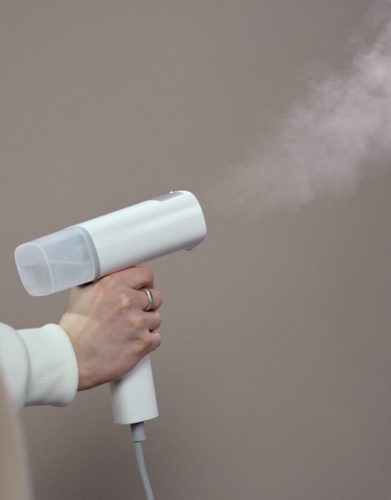There’s nothing like enjoying a relaxing night in on your plush sofa or reclining chair. When you buy a new sofa, it quickly becomes a comfortable spot to sit with the family, a group of friends, or with your pets. The living room sofa often becomes a favorite spot for everyone, though it quickly collects dirt, pet stains, debris, and spills that may go unnoticed.
Upholstery fabrics are not always easy to clean with a cloth, and stubborn stains discovered after a few days can take a bit of effort to remove. Steam cleaning your upholstered furniture is the most efficient way to lift dirt and grime from the fabric and maintain the quality of your sofa or chair.
While a professional upholstery cleaning service seems like the only option, you can safely and effectively remove stains with your steam cleaner within minutes.
How to Prepare Your Upholstered Furniture for Steam Cleaning
There are a few essential steps to take before you begin steam cleaning your sofa or upholstered chair. These include checking the label on your furniture for instructions, determining if steam cleaning is an available option, and preparing the fabric for treatment.
When you’re shopping for an upholstery cleaner, you’ll want to invest in the best steam cleaner for your furniture. The Dupray Neat steam cleaner is a great option to consider if you’re searching for a high-quality upholstery steam cleaner.
Check Labels on Your Furniture
Before you prepare your upholstery for steam cleaning, it’s crucial to ensure that your chair, sofa, or loveseat can be safely treated with steam. Some labels have an “X,” which means the fabric isn’t safe for cleaning and may become damaged as a result. The “X” indicates that any water exposure to your sofa upholstery will damage the fabric.
If your sofa or reclining chair label includes “SW,” this means it’s water and solvent safe, and it’s safe for steam cleaning without risking damage to your fabric. If you don’t find any clear instructions or labels that specify whether a steam clean is an option, contact the manufacturer for advice or read instructions or information included in purchasing your sofa or chair.
Vacuum Your Furniture
Using a handheld vacuum or smaller attachment, thoroughly vacuum the entire fabric area of your couch or chair. If your sofa has cushions or large pillows, remove them and vacuum in between and underneath to pick up additional debris and dust that may fall and collect.
If you notice large debris, sweep and pick up these items with a brush and dustpan, then continue vacuuming the smaller dust particles until your sofa is cleared of any crumbs, pet hair, and dirt.
Spot Clean Stains and Grime
If your couch or sofa contains a few stubborn stains, you’ll need to spot clean upholstery before steam cleaning. Before you treat a tough stain, read the manufacturer’s instructions and labels so that you use an upholstery cleaner that won’t discolor or damage your fabric. Take note of any recommendations and avoid products that may cause damage.
Oil-based stains are best to remove with rubbing alcohol and white vinegar before steam cleaning, and you can also use baking soda and warm water with cornstarch. Gently brush the natural cleaning solution to remove the stain using a scrub brush.
Tough stains, such as nail polish or paint, may be more difficult to remove and require a robust cleaner. Always consult with a professional source or manufacturer before trying a commercial brand to ensure it doesn’t ruin or discolor your fabric.
Specific stains caused by pets, food particles, dirt, and grime are effectively removed by steam cleaning alone, though any oil-based stains require spot cleaning in advance.

Condition Your Upholstery Fabric
Once you’ve completed the previous steps to prepare your fabric sofa, a conditioner is required to prepare the fabric before the steam cleaning process. Conditioning the material prevents the upholstery from becoming stiff or starchy while promoting the steam cleaning process to lift dirt that’s been ground into the fibers effectively.
Choose a conditioner that’s compatible with your sofa’s fabric, as some products contain chemicals that may damage specific material. Spray the chair or couch evenly and ensure all the corners and crevices are adequately coated. Allow the furniture to sit and dry for several minutes, then add fabric shampoo. Use a brush or microfibre cloth to spread this solution into the material.
Step-By-Step Upholstery Steam Cleaner Guide
When you’re prepared to begin steam cleaning, it’s essential to use a quality upholstery steam cleaner or a handheld steam cleaner that’s equipped for upholstery. You can also use a floor steam cleaner with smaller attachments, as long as it’s designed to deep clean sofa fabric and upholstery specifically.
- Prepare the steam cleaner by filling the tanks with distilled water. According to the manufacturer’s manual, add a safe cleaner compatible with the fabric furniture and measure the correct amount.
- Choose the best attachment for your fabric, which may include a brush attachment or steam mop. An oscillating brush or similar attachment works well with sturdy material for a deep clean.
- Switch the steam cleaner to “on” and wait until your machine is heated and ready to steam.
- If your sofa or reclining chairs includes matching pillows or cushions, start steam cleaning these items first, then place these loose items to the side so they can fully dry.
- Begin at one side of the fabric, and move the steam cleaner in straight, even strokes. Avoid holding the machine in one area for too long, as this may cause certain spots to get too wet and take much longer to dry. If there are specific areas with heavy stains or dirt, keep steaming evenly and go over these areas consistently.
Note: If you have a lot of surfaces to cover, you can use the continuous steam option, which allows a steady stream of steam without pressing the button as you work.
- When you are finished, allow the furniture to dry completely. This step may take up to twelve hours or longer, depending on the temperature and humidity in your home. Ideally, it’s best to steam clean upholstery in a dry environment or when there’s a cool breeze without any humidity in the air.
- Once your sofa is dry, you’ll notice a softer, cleaner finish. The fabric should be soft and visibly brighter after cleaning. If you notice persistent stains or a trace of dirt left after cleaning, you can treat these spots with a homemade spot cleaner.
Tips for Keeping Your Furniture Upholstery Fresh and Durable
Upholstery steam cleaning is a great way to keep your furniture looking fresh and staying in good condition for many years. It’s also a meaningful way to remove and prevent dust mites, stains, dirt, and debris. A few essential tips to keep in mind to protect your furniture include:
- Limit your pets near or around furniture. If you enjoy relaxing on the couch with your pet, cover the sofa with an older blanket or stain-resistant cloth to protect the upholstery fabric.
- Avoid eating and drinking on the sofa to prevent spilling
- Keep a mild dish soap, vinegar, baking soda, and a brush on hand to quickly clean a fresh spill or stain and prevent further damage.
Bottom Line
Steam cleaning upholstery is a rewarding practice that will keep your sofa, reclining chairs, cushions, and pillows looking great for many years.
